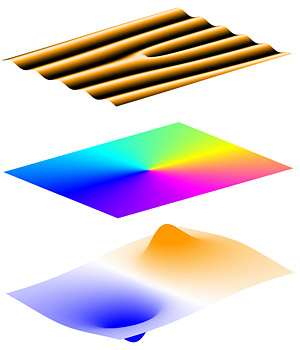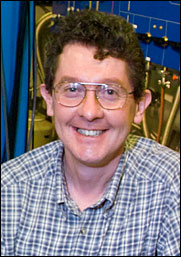Link Between Competing Phases in Cuprates Leads to New Theory
Discovery in parent of one high-temperature superconductor may lead to predictive control
July 21, 2011
UPTON, NY — A team of scientists studying the parent compound of a cuprate (copper-oxide) superconductor has discovered a link between two different states, or phases, of that matter — and written a mathematical theory to describe the relationship. This work, appearing in the July 22, 2011, issue of Science, will help scientists predict the material’s behavior under varying conditions, and may help explain how it’s transformed into a superconductor able to carry current with no energy loss.
“The ultimate goal is to use what we learn to design copper-oxide materials with desired properties — such as superconductors that operate at temperatures warm enough to allow more widespread use in applications designed to transform the distribution of electricity,” said J.C. Séamus Davis, a co-author on the paper. Davis is Director of the Center for Emergent Superconductivity at the U.S. Department of Energy’s Brookhaven National Laboratory and the J.G. White Distinguished Professor of Physical Sciences at Cornell University.
“If you want to understand how to use a material, you need a theoretical understanding of how it behaves under different conditions,” Davis said. For example, there would be no desktop computers if we didn’t first have a theory to explain the behavior of silicon, the main component of the computer’s memory and processing chips. “To attain that kind of control over cuprate superconductors — materials that have enormous potential for improving energy efficiency and storage — we need that quantitative and predictive understanding.”
 enlarge
enlarge
This graphic shows a distortion in the “stripey” electronic structure of a copper-oxide material (represented by the fork in the top illustration), and how that distortion rotates around a central defect (as illustrated by the color pinwheel below). After discovering the existence of this long sought ‘topological’ defect in the electronic structure, the researchers found that its rotation is also linked to the intensity of a competing electronic phase (indicated by peaks and depressions in the lower illustration). This provided a key clue to the correct mathematical theory explaining the link between the two phases. The scientists hope this theory will lead to predictive control of these electronic phases — and eventually to an understanding of their impact on superconductivity.
One challenge is that copper-oxide superconductors have lots of other states that can compete with superconductivity. To begin to understand these different phases — which are dominant, which are weaker, how they interact, and what happens to alter the balance of “power” — the experimentalists* on the team used a technique called spectroscopic image-scanning tunneling microscopy, developed by Davis, to directly visualize the electrons in each phase at the atomic level.
“With this technique, we can look for how the competition between two forms of matter works by direct observation,” Davis said.
One state has a periodic modulation of the electronic structure, like a wave with periodic peaks and valleys that impart a “stripe” pattern over the entire crystalline structure of the material. The other state has variations within every unit cell of the same crystal — that is, variations in a property of each individual electron.
Davis’ technique was able to detect “topological defects” — swirling vortex-like distortions in the stripey component of the electronic structure — that provide a link from one of these ordered phases to the other.
These topological defects are similar to those observed in liquid crystal states, which led theoretical physicists in the group — Eun-Ah Kim of Cornell, Michael Lawler of Binghamton University, Subir Sachdev of Harvard University, and Jan Zaanen of Leiden University — to devise a theory that draws on experience with those materials. This new theory explains the coexistence of the two cuprate states, and predicts their interplay at the atomic scale.
The theory should help predict the behavior of the material at the macroscopic scale — how it behaves in the real world — and how that behavior varies as a function of material-specific conditions, such as crystal symmetry.
“We don’t know yet how this will relate to the mechanism of high-temperature superconductivity, Davis said, “but we aspire to answer that question.”
This research was supported by the DOE Office of Science (through the Center for Emergent Superconductivity, an Energy Frontier Research Center), the National Science Foundation, the Japanese Ministry of Science and Education, the Japan Society for the Promotion of Science, and the Netherlands Organization for Scientific Research.
*Additional collaborators: Andrej Mesaros (Leiden University and Cornell); K Fujita (Cornell, Brookhaven, and University of Tokyo); Hiroshi Eisaki (Institute of Advanced Industrial Science and Technology, Japan); S Uchida (University of Tokyo).
2011-11307 | INT/EXT | Newsroom










